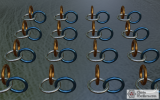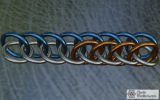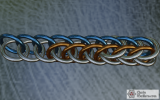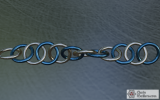Introduction
Welcome to the second article in my series on CCT (the first can be found here). This entry is going to assume that you are familiar with the elements and concepts that have already been introduced. I will cover a bunch of additional information that wasn't necessary when explaining the "basics". While I will, once again, try to keep topics grouped there is a lot of ground to cover so there will be some jumping around.
Translations - Part II
You didn't think extensions were the only type of translation that can be done, did you?.Expansion
 Expansions are when you take an extension and translate on an axis that is perpendicular to the axis of extension. Expansions are used to make bands and sheets
Expansions are when you take an extension and translate on an axis that is perpendicular to the axis of extension. Expansions are used to make bands and sheetsElevation
 Elevations are when you take an expansion and translate on an axis that is perpendicular to the axis of extension and the axis of expansion. Elevations are one way of making 3D Objects.
Elevations are when you take an expansion and translate on an axis that is perpendicular to the axis of extension and the axis of expansion. Elevations are one way of making 3D Objects.Translation Notes:
- Expansions may require modification to the extension before being translated.
- Elevations may require modification to the expansion before being translated.
- Expansions and Elevations are considered Modifications
Cell & Segment
I've been having a hard time figuring out where this section could go as it's an overlapping minefield. Currently, many of these terms are used interchangeably in the chainmaille community. In my opinion, random usage is one of the greatest sources of confusion among maillers. These are the basics on how they are defined in CCT and they (along with units) will eventually get their own in depth article. Special thanks to
 moaatt
who pointed out that while I defined a "root cell", I didn't define "Cell".
moaatt
who pointed out that while I defined a "root cell", I didn't define "Cell".
Cell
A cell is a group of connected rings that act as a single element. While root cells are the root of all chainmaille, it would be pretty boring if all we could make were 2 in 1 chains or Half Persian 3 in 1, so from there we go to the first cell type, Base Cells.
Base Cells
 A base cell is a root cell that has had a modification, transformation, and/or variation applied. On their own, are unstable (they can be manipulated into many configurations and different applications may result in the same base cell). The base cells pictured in the render are by no means the only base cells.
A base cell is a root cell that has had a modification, transformation, and/or variation applied. On their own, are unstable (they can be manipulated into many configurations and different applications may result in the same base cell). The base cells pictured in the render are by no means the only base cells.Weave Cells
 Weave Cells are two or more root cells/base cells/segments that include all the cellular connections, rotations, modifications, transformations, variations, grains and traits needed to be translated on as many axis as needed for the Weave Form being made. Different weave forms of the same weave may have different weave cells. Pictured in the render are a small sample of weave cells..
Weave Cells are two or more root cells/base cells/segments that include all the cellular connections, rotations, modifications, transformations, variations, grains and traits needed to be translated on as many axis as needed for the Weave Form being made. Different weave forms of the same weave may have different weave cells. Pictured in the render are a small sample of weave cells..Weave Cell Notes:
- Other than in the case of spiraling weaves, weave cells are always translated without rotation.
- While many different weaves may use the same base cell(s), the cellular connections between the base cells will differ, resulting in different weave cells.
- Weaves may have more than one weave cell.
Segment
An incomplete grouping of connected rings from multiple cells present in a weave. Segments can be taken from all weave forms.Weave Forms
Weave forms are the different ways that we, as chainmaillers, present weaves. Weave Cells may need to modified to allow for the translations necessary for the different weave forms. CCT recognizes four primary weave forms:Unit
 Weave form where translations are done around a central origin ring(s) or point. Units start with 3 elements + the origin.
Weave form where translations are done around a central origin ring(s) or point. Units start with 3 elements + the origin.Chain
 Weave form where translations are done along a single axis and connected to the previous cell. (Extension)
Weave form where translations are done along a single axis and connected to the previous cell. (Extension)Sheet
 Weave form where translations are done along two axis. (Extension & Expansion) The second translation is done along an axis perpendicular to the first and connected to the previous extension. Sheets are expanded chains.
Weave form where translations are done along two axis. (Extension & Expansion) The second translation is done along an axis perpendicular to the first and connected to the previous extension. Sheets are expanded chains.3D Object
 Weave form where translations are done along three axis. (Extension, Expansion, & Elevation) The third translation is done along an axis perpendicular to both the first and second and connected to the previous expansion OR where translations result in a sphere around a central point.
Weave form where translations are done along three axis. (Extension, Expansion, & Elevation) The third translation is done along an axis perpendicular to both the first and second and connected to the previous expansion OR where translations result in a sphere around a central point.
Weave Form Notes:
- There are multiple weave sub forms including (these definitions may be refined and/or revised):
- Radial Unit - When at least 3 isolated elements all radiate from a central ring(s).

- Loop Unit - When a chains end connects to its' beginning. A loop unit requires at least 3 elements. Yes, a seamless chain is essentially a really big loop unit.

- Hybrid Unit - When a loop unit is reinforced by a central ring(s). Can also be seen as a radial unit where the radial elements are not isolated from each other.

- 3/4 chain - The mid point between a chain and a tube or a chain and a band.

- Tube - At least two chains rotated around a central axis and connected to each other on their edges. Connection of the chains may be done with a modification.

- Band - At least two chains connected on a single edge, or an expansion termination of a chain, In bands the extension is longer than the expansion.

- Cross Band - At least two chains connected on a single edge. In cross bands the expansion is longer than the extension.

- Band Notes
- Bands (both types) that are not terminated can be further expanded into sheets.
- Band Notes
- Web Sheet - Still not really sure how to describe this, but don't want to hold up publishing the rest of the information. What are currently classified as "Web Sheets" can, for now, be found here.
- Radial Unit - When at least 3 isolated elements all radiate from a central ring(s).
Weave Classes
Weave classes are the major categories that weaves belong to. Weaves can belong to multiple categories:Progression
 Progressions in CCT are when a cell has a cellular connection to more than one previous root or base cell. This usually makes for a much denser version of the original weave since there are more cells occupying the same amount of space. In the attached render, we have a segment of 2 in 1 chain (which is also a terminated root cell) and show a progression of European 4 in 1. European 4 in 1 requires a minimum of 2 segments, European 6 in 1 requires a minimum of 3 segments, and European 8 in 1 requires a minimum of 4 segments before any difference can be seen in the samples.
Progressions in CCT are when a cell has a cellular connection to more than one previous root or base cell. This usually makes for a much denser version of the original weave since there are more cells occupying the same amount of space. In the attached render, we have a segment of 2 in 1 chain (which is also a terminated root cell) and show a progression of European 4 in 1. European 4 in 1 requires a minimum of 2 segments, European 6 in 1 requires a minimum of 3 segments, and European 8 in 1 requires a minimum of 4 segments before any difference can be seen in the samples.Modifications
Modifications are another term you may be familiar with, but how they are defined in CCT may differ from from you know. In CCT, a modification is the addition of a ring (or rings) that results in connections that did not previously exist. There are currently four modification types recognized by CCT.
- Expansion - An extension translated on an axis that is perpendicular to the axis of extension.
- Elevation - An expansion translated on an axis that is perpendicular to the axis of extension and the axis of expansion.
- Faceted - Addition of a grain(s) to an edge of a chain that is normally a layer or mirror of an existing grain.

- Reinforced - Addition of a ring(s), creating a new connection(s) to reinforce specific positioning of existing rings.

- Modification Notes:
- Expansions and Elevations are considered modifications because they are adding new rings and connections on an edge where they were previously not present.
Transformations
Transformations are, to my knowledge, a new term in regards to chainmaille. Transformations are specific simple changes made to existing ring(s) in a weave that, currently, in many cases (but not all for some reason) are considered a completely different weave. CCT currently recognizes three types of transformation:
- Dilation - The use of two different ring sizes in root cells (this may not be the final definition), e.g. in CCT Dragon Tail is considered a dilation of Half Persian 3 in 1.

- Grain - Replacement of a grain with a different grain, changing the direction of a grain or an existing ring in a cell.

- Oblique - Making a connection between two rings, that did not previously exist, from a pair of rings that were not previously connected, e.g. in CCT Cross Eyed Persian is considered an oblique of Full Persian 6 in 1.

Variations
Variations are modifications that result in aesthetic changes to a weave. Variations can be mixed and matched, applied in part or in full, and in most cases applied to each other as well as a weave. All variations are not necessarily applicable to all weaves. CCT currently recognizes five types of variations:
- Captive - The addition of an element that is held in place by surrounding rings without connecting with them.

- Mobized - The replacement of a single ring with a 3 (or more) ring mobius, used as a single ring.

- Nested - The addition of a ring(s), on the same plane, inside or outside of a ring, used as a single ring. Commonly known as "Scaled".

- Orbital - The addition of a ring(s) around a ring, the internal connection of a cell, or a cellular connection between cells.

- Stacked - The addition of a ring(s), on the same plane, above or below and/or in front of or behind a ring, used as a single ring. Commonly known as "Kinged".

Odds & Ends
Grains
I mention grains, but didn't really discuss them as they will be getting their own article at some point. Some basics need to be mentioned. Grains are created based on where cells are connected in relation to the position of the rings in the previous cell. CCT currently recognizes 6 grains:
Grain Note: All grains other than Twist and Spiral devolve into a pile of rings without an additional cross grain. Twist and Spiral devolve into 2 in 1 chain.Additional Notes
Base cells - the definition above will probably be updated at some point. I believe that it may currently be too inclusive. The following render shows other "base cells" based only upon the "stacking" variation, however that might be too restrictive.
Base weaves - Base weaves are definitely a weave class, but too many weaves would be included as "Base Weaves" based upon the current definition of base cells.
Segmented - Segmentation does occur, but it is still under investigation whether it should be considered a modification, transformation, or variation.
Units - You may have noticed that units have a requirement of 3 elements + origin. This is in the interest of clearing up some major overlap between units, cells and segments. When looked at individually (which is what CCT is all about) a radial unit with only the origin and 1 element (radial 1) could be a root or base cell and/or a segment, and a radial unit with only the origin and 2 elements (radial 2) could be a base cell, weave cell and/or a segment.
Conclusion
Well, that covers most of the additional basic concepts in my head regarding CCT. Knowing me, I probably forgot something important  . As I stated in my first article, I'm not a textbook/technical writer and CCT is constantly evolving. What this means is that information/definitions in this article (and the previous one) are tentative. Changes may be made in the case of new discoveries, changes in understanding, and/or better definitions. In such cases, the new information will be posted in the associated discussion thread, as well as updated in the article. There is still more to come, including more "in depth" articles about some of the concepts. presented.
. As I stated in my first article, I'm not a textbook/technical writer and CCT is constantly evolving. What this means is that information/definitions in this article (and the previous one) are tentative. Changes may be made in the case of new discoveries, changes in understanding, and/or better definitions. In such cases, the new information will be posted in the associated discussion thread, as well as updated in the article. There is still more to come, including more "in depth" articles about some of the concepts. presented.
As always, if you have any questions or constructive criticism regarding CCT please feel free to let me know in the discussion thread for this article.






